The Service Lifecycle Management Application Market is estimated to be valued at USD 1.8 billion in 2025 and is projected to reach USD 3.8 billion by 2035, registering a compound annual growth rate (CAGR) of 7.7% over the forecast period.
The Service Lifecycle Management (SLM) Application market is experiencing significant growth driven by the increasing adoption of digital transformation initiatives and the demand for efficient management of service operations across industries. The future outlook of this market is shaped by the rising focus on customer experience, operational efficiency, and real-time data analytics, which enable organizations to optimize service delivery and reduce costs.
The shift toward cloud-based and software-as-a-service models has accelerated the adoption of service lifecycle management solutions, allowing companies to deploy scalable and flexible systems without significant upfront infrastructure investment. Additionally, growing competition in customer-centric industries and the emphasis on predictive and proactive maintenance are driving investments in SLM applications.
The integration of advanced analytics, artificial intelligence, and automation within these solutions is enhancing decision-making capabilities and service performance As organizations increasingly prioritize data-driven insights and streamlined service processes, the Service Lifecycle Management Application market is expected to witness sustained expansion across global markets.
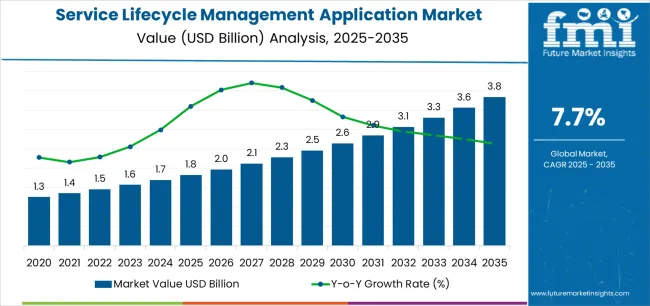
| Metric | Value |
|---|---|
| Service Lifecycle Management Application Market Estimated Value in (2025 E) | USD 1.8 billion |
| Service Lifecycle Management Application Market Forecast Value in (2035 F) | USD 3.8 billion |
| Forecast CAGR (2025 to 2035) | 7.7% |
The market is segmented by Software Type, Service-Based Model, Solution, and End-Use Industry and region. By Software Type, the market is divided into Web-Based Service Lifecycle Management Software and Cloud-Based Service Lifecycle Management Software. In terms of Service-Based Model, the market is classified into Depot-Based SLM Models, Dealer-Based SLM Models, Performance-Based SLM Models, and Field-Based SLM Models. Based on Solution, the market is segmented into Customer Contact And Support, Field Service Management, Warranty And Service Management, and Service Parts Information Management.
By End-Use Industry, the market is divided into Automotive And Transportation, Aerospace And Defense, Medical Equipment, High Technology, Telecommunications, and Industrial Machineries And Equipment. Regionally, the market is classified into North America, Latin America, Western Europe, Eastern Europe, Balkan & Baltic Countries, Russia & Belarus, Central Asia, East Asia, South Asia & Pacific, and the Middle East & Africa.
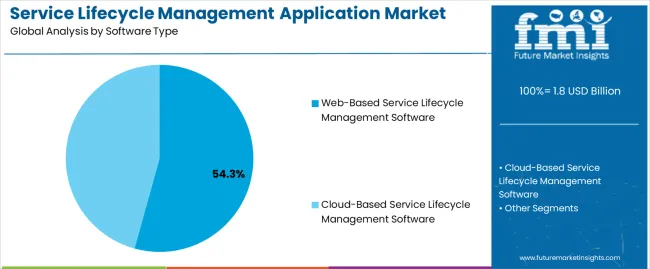
The web-based service lifecycle management software segment is projected to hold 54.30% of the market revenue share in 2025, establishing it as the leading software type. This growth is driven by the flexibility, accessibility, and scalability offered by web-based solutions, which allow organizations to manage service operations remotely and efficiently. The segment has been supported by increasing investments in cloud infrastructure and the need for real-time monitoring of service activities.
Web-based SLM software enables seamless integration with other enterprise systems, improving collaboration and workflow automation across departments. The ability to provide timely analytics and reporting enhances operational efficiency and supports proactive decision-making.
Furthermore, the demand for solutions that reduce IT overhead and provide continuous software updates has reinforced the adoption of web-based models These factors collectively contribute to the dominance of this segment in the Service Lifecycle Management Application market.
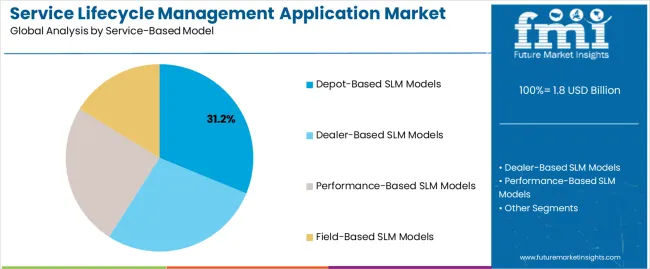
The depot-based SLM models segment is expected to account for 31.20% of the market revenue share in 2025, making it a prominent solution type. This segment has been driven by the structured approach offered by depot-based models, which centralize maintenance, repair, and service operations to optimize efficiency and reduce downtime.
The consolidation of service tasks in dedicated depots ensures standardized processes, better resource utilization, and improved quality control. Depot-based models also allow companies to implement preventive maintenance programs and track service performance effectively.
The segment’s growth is further reinforced by industries requiring centralized service management and strong compliance with operational standards The ability to monitor asset performance, manage spare parts inventory, and streamline logistics has strengthened the adoption of depot-based models, contributing to their significant market share.
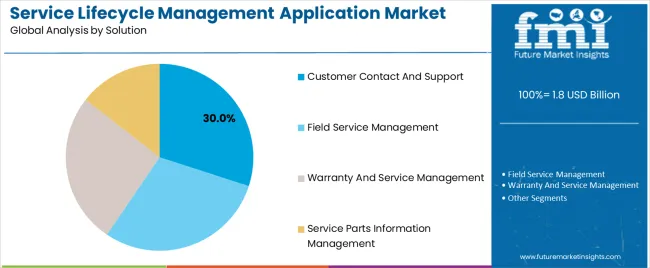
The customer contact and support segment is anticipated to hold 30.00% of the market revenue share in 2025, reflecting its critical role in ensuring customer satisfaction and service quality. Growth in this segment is influenced by the increasing emphasis on customer experience and the demand for efficient resolution of service requests.
SLM solutions that integrate customer support functions enable timely responses, tracking of service history, and effective communication with clients. The ability to analyze customer interactions and service feedback supports continuous improvement and drives operational efficiency.
Furthermore, the adoption of automated support tools and AI-driven analytics enhances service response times and problem resolution, strengthening customer loyalty The rising need for businesses to maintain high service standards and ensure compliance with service level agreements has further propelled the adoption of customer contact and support solutions within the Service Lifecycle Management Application market.
The global demand has historically developed at a CAGR of 5.90%. However, sales have stated to advance at a better pace, displaying a CAGR of 8.10% from 2025 to 2035.
| Attributes | Details |
|---|---|
| Market Historical CAGR for 2020 to 2025 | 5.90% |
The pandemic has impacted the SLM market, leading to small businesses closing and increasing demand for existing products, with a projected increase in dependency on commercial sectors.
The pandemic significantly impacted the global economy, SLM applications demand, industry development, and business closures due to a lack of finance.
Artificial intelligence improves real-time applications, particularly predictive analytics, in service lifecycle management and aftermarket support services. It reduces human variability and ensures faster problem-solving, product availability, and customer query resolution.
In sectors that utilize metal, SLM applications are becoming prevalent since the platforms track performance and offer post-purchase services like welding and maintenance.
Widespread Demand for the Short Release Timeline to Propel the Market
Third-platform Technology Offerings Advance the Development of the SLM Tools
Rise of Research and Development in Automated SLM to Lift Market Value
The following part offers an in-depth analysis of segments of the SLM market. The demand for web-based service lifecycle management software is significant, whereas the adoption of depot-based SLM Models is anticipated to increase in 2025.
| Attributes | Details |
|---|---|
| Top Software Type | Web-based Service Lifecycle Management Software |
| Market share in 2025 | 54.3% |
Web-based SLM software is anticipated to account for 54.3% of the SLM application market in 2025. Service lifecycle management application solutions are increasingly being deployed via web-based software. Industry experts estimate that this trend is anticipated to continue to dominate the market for a subsequent decade.
Web-based service lifecycle management systems offer flexibility and customization. These make updates and modifications to meet an organization's unique demands. Over 50% of workloads are performed on web-hosted services due to scalability, security, and improved collaboration.
The web-based SLM solutions enhance IT operations, service delivery, and customer experience. These help organizations achieve goals and stay competitive, benefiting organizations of all sizes.
| Attributes | Details |
|---|---|
| Top Service-based Model | Depot-based Service Lifecycle Management Models |
| Market share in 2025 | 31.20% |
The demand for depot-based SLM models is augmented, with a market share of 31.2% in 2025. Depot-based models give an integrated perspective of service delivery, planning, and analysis. This improves operational efficiency and cost-effectiveness for enterprises. They are complete service management systems that encompass a product's whole lifecycle.
Through process simplification, increased information quality, fewer mistakes in manual data input, and improved departmental data visibility, depot-based models give businesses a competitive edge. As a result, decisions are made more effectively, customers are happier, and profits rise.
Depot-based models provide several advantages, including enhanced competitiveness, cost-effectiveness, and operational efficiency, all of which are anticipated to propel market expansion throughout the projected timeframe.
Based on the statistical data, industries in Germany and Japan are set to develop relatively in the upcoming decade. Simultaneously, the SLM application sector in Australia and China is on the way to hitting the roof due to several factors. The SLM technology sector in the United States is anticipated to climb gradually in the upcoming decade.
| Countries | CAGR from 2025 to 2035 |
|---|---|
| United States | 4.90% |
| Germany | 3.50% |
| China | 8.60% |
| Japan | 2.80% |
| Australia | 11.60% |
The United States is anticipated to hold a CAGR of 4.9% from 2025 to 2035 in the service lifecycle management application market.
The United States is a tech-savvy nation, particularly North America, which has a competitive edge in the adoption of emerging technologies like smartphones and cloud platforms. This openness to new technologies allows organizations to gain a competitive edge over their counterparts.
The United States’ robust financial position has enabled significant investment in advanced technologies. This investment has given the country a competitive edge in various industries like healthcare, finance, and manufacturing, thereby transforming the industry.
The United States has been a pioneer in embracing emerging technologies like artificial intelligence, blockchain, and IoT. These have revolutionized operations, opened new business opportunities, and generated significant revenue streams for organizations.
Demand for SLM software in Germany is estimated to develop at a CAGR of 3.5%, with firms developing innovative solutions for production tracking.
Germany is predicted to emerge significant in the SLM software market due to the presence of major players and the increasing adoption of next-generation technologies like 5G, ML, AR, IoT, LTE, and additive manufacturing.
Germany is anticipated to hold significance in the European market share. This is due to the rapid integration of advanced technologies in various industries, particularly in aerospace, automotive, and healthcare, leading to increased demand for SLM software.
The service lifecycle management application market in Germany is also thriving due to its active investment in research and development, high level of innovation, and competitiveness in SLM software. The region's favorable regulatory environment, supportive government policies, and skilled workforce further contribute to its growth.
China is on the brink of a significant market expansion in service management apps, with a projected CAGR of 8.6% from 2025 to 2035.
In China, SLM is in demand as a comprehensive strategy. It integrates various functions like service parts management, technical communication, field service management, and product support operations to ensure maximum customer satisfaction and asset uptime.
Chinese companies use SLM to manage their inventory, procurement, storage, and distribution of service parts. SLM facilitates communication across teams, including product development, design, engineering, and customer support, ensuring alignment and alignment of stakeholders in the product lifecycle.
Service lifecycle management is a necessary practice for Chinese companies, ensuring maximum customer satisfaction and asset uptime by aligning various functions and operations.
Between 2025 and 2035, Australia is set to experience a remarkable CAGR of 11.6% in the SLM solutions sector. The country's robust economic growth can be attributed to the increased adoption of advanced technologies in various industries and the continued research into the development of novel technologies.
The automated service lifecycle management field is predicted to grow in Australia. This is due to the increasing adoption of automation technologies and the growing demand for services that streamline business processes and improve operational efficiency.
Open-source service hubs are envisioned to boost growth in the Australian market. They enable service providers to use various tools and resources to enhance their offerings, drive innovation, and share knowledge. This accelerates the development and adoption of new service solutions.
The demand for SLM applications in Japan is foreseen to experience a CAGR of 2.8% from 2025 to 2035.
Through the use of data analytics and predictive maintenance technologies, SLM helps businesses in Japan manage service operations, including maintenance, repair, and upgrades. This helps to identify possible problems early on and take proactive steps to reduce downtime.
In Japan, supply chain management, or SLM, helps businesses monitor product performance, collect customer feedback, and make ongoing improvements to offers. This allows organizations to build lasting connections with customers by delivering dependable, superior products and services.
The outlook for service lifecycle management application solutions in Japan is positive. Providers that can deliver innovative, efficient, and cost-effective solutions are likely to experience strong demand and growth opportunities over the forecast period.
Service lifecycle management (SLM) application solution providers are investing in research and development to support future technologies and enhance their service offerings and customer base. These companies are also acquiring or partnering with other companies to strengthen their market position and gain a competitive edge.
Due to the increased use of SLM applications, the global product lifecycle management (PLM) industry is mounting considerably. This has LED major companies to concentrate on research and development to provide novel solutions.
The future of the SLM application solutions market looks promising, with a growing number of companies investing in research and development to develop new and innovative solutions. Such market trends are foreseen to continue as companies seek to stay ahead of the curve and meet the ever-changing needs of their customers.
Recent Developments in the Service Lifecycle Management Application Market
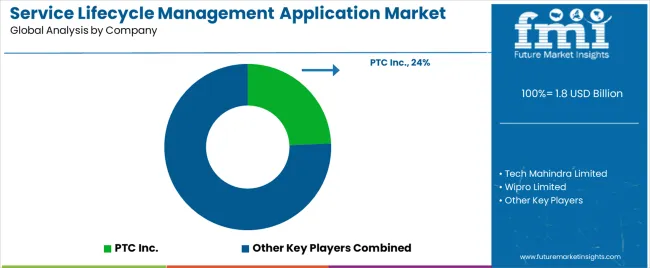
The global service lifecycle management application market is estimated to be valued at USD 1.8 billion in 2025.
The market size for the service lifecycle management application market is projected to reach USD 3.8 billion by 2035.
The service lifecycle management application market is expected to grow at a 7.7% CAGR between 2025 and 2035.
The key product types in service lifecycle management application market are web-based service lifecycle management software and cloud-based service lifecycle management software.
In terms of service-based model, depot-based slm models segment to command 31.2% share in the service lifecycle management application market in 2025.






Our Research Products

The "Full Research Suite" delivers actionable market intel, deep dives on markets or technologies, so clients act faster, cut risk, and unlock growth.

The Leaderboard benchmarks and ranks top vendors, classifying them as Established Leaders, Leading Challengers, or Disruptors & Challengers.

Locates where complements amplify value and substitutes erode it, forecasting net impact by horizon

We deliver granular, decision-grade intel: market sizing, 5-year forecasts, pricing, adoption, usage, revenue, and operational KPIs—plus competitor tracking, regulation, and value chains—across 60 countries broadly.

Spot the shifts before they hit your P&L. We track inflection points, adoption curves, pricing moves, and ecosystem plays to show where demand is heading, why it is changing, and what to do next across high-growth markets and disruptive tech

Real-time reads of user behavior. We track shifting priorities, perceptions of today’s and next-gen services, and provider experience, then pace how fast tech moves from trial to adoption, blending buyer, consumer, and channel inputs with social signals (#WhySwitch, #UX).

Partner with our analyst team to build a custom report designed around your business priorities. From analysing market trends to assessing competitors or crafting bespoke datasets, we tailor insights to your needs.
Supplier Intelligence
Discovery & Profiling
Capacity & Footprint
Performance & Risk
Compliance & Governance
Commercial Readiness
Who Supplies Whom
Scorecards & Shortlists
Playbooks & Docs
Category Intelligence
Definition & Scope
Demand & Use Cases
Cost Drivers
Market Structure
Supply Chain Map
Trade & Policy
Operating Norms
Deliverables
Buyer Intelligence
Account Basics
Spend & Scope
Procurement Model
Vendor Requirements
Terms & Policies
Entry Strategy
Pain Points & Triggers
Outputs
Pricing Analysis
Benchmarks
Trends
Should-Cost
Indexation
Landed Cost
Commercial Terms
Deliverables
Brand Analysis
Positioning & Value Prop
Share & Presence
Customer Evidence
Go-to-Market
Digital & Reputation
Compliance & Trust
KPIs & Gaps
Outputs
Full Research Suite comprises of:
Market outlook & trends analysis
Interviews & case studies
Strategic recommendations
Vendor profiles & capabilities analysis
5-year forecasts
8 regions and 60+ country-level data splits
Market segment data splits
12 months of continuous data updates
DELIVERED AS:
PDF EXCEL ONLINE
Application Management Services Market Analysis – Trends & Forecast 2017-2027
IT Service Management Tools Market Growth – Trends & Forecast through 2034
Field Service Management Market Size and Share Forecast Outlook 2025 to 2035
Cash Management Services Market – Trends & Forecast 2025 to 2035
Asset Management Services Market Size and Share Forecast Outlook 2025 to 2035
Key Management as a Service Market
Service Integration & Management Market Report – Forecast 2017-2027
Application Crowdtesting Service Market Size and Share Forecast Outlook 2025 to 2035
Contract Lifecycle Management Market Growth – Trends & Forecast 2025 to 2035
Decision Management Applications Market Size and Share Forecast Outlook 2025 to 2035
Facility Management Services Market Analysis – Trends, Growth & Forecast 2025 to 2035
Cloud Field Service Management (FSM) Market Size and Share Forecast Outlook 2025 to 2035
IoT Application Development Services Market Size and Share Forecast Outlook 2025 to 2035
Agile Application Life-Cycle Management Market Size and Share Forecast Outlook 2025 to 2035
Public Cloud Application Services Market Analysis - Size, Share, and Forecast Outlook 2025 to 2035
Private Wealth Management Service Market Size and Share Forecast Outlook 2025 to 2035
Demand for Cash Management Services (CMS) in USA Size and Share Forecast Outlook 2025 to 2035
Demand for Cash Management Services (CMS) in Japan Size and Share Forecast Outlook 2025 to 2035
Quality Process Management Application Market Size and Share Forecast Outlook 2025 to 2035
Analyzing Supplier Quality Management Applications Market Share

Thank you!
You will receive an email from our Business Development Manager. Please be sure to check your SPAM/JUNK folder too.
Chat With
MaRIA